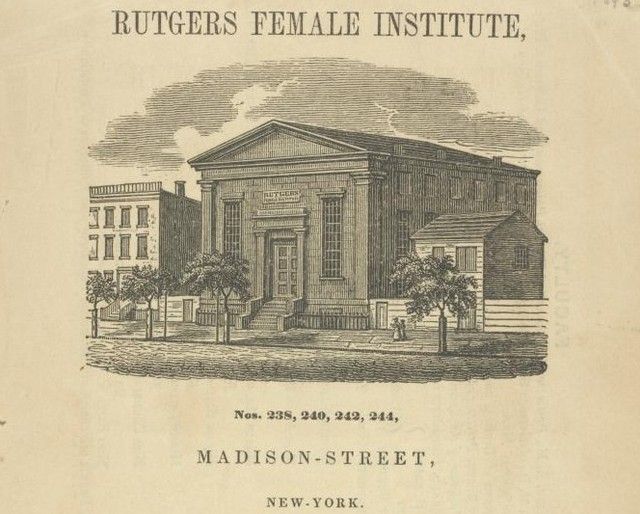Last Chance to Catch NYC's Holiday Notalgia Train
We met the voices of the NYC subway on our nostalgia ride this weekend!



Rutgers Female Institute, 1843. Image via NY Public Library Digital Collections
Rutgers Female Institute opened as New York City’s first institution of higher education for women in 1839. Located in a new building on Madison Street in what is now the Lower East Side, it offered a one-year course of study at the higher education level as well as classes for younger girls.

1857 Perris & Browne Map showing Madison Street location of Rutgers Female Institute. Image via NY Public Library Digital Collection
The school was named for Henry Rutgers, a Revolutionary War hero whose estate provided the land for the facility. He is also the namesake of New Jersey’s Rutgers University, but there was no formal connection between the two.
In 1860 Rutgers Female Institute followed the general direction of Manhattan development and moved uptown to 487-491 Fifth Avenue, across the street from the Croton Distributing Reservoir (now the New York Public Library). The new facility was built in 1856 as the “House of Mansions,” an unsuccessful attempt at an early type of luxury apartment building.
In 1867 a new charter from the state upgraded it from Rutgers Female Institute to Rutgers Female College and it began to offer a four year bachelors of arts degree recognized by the state Board of Regents.
At the same time, the college announced plans to develop a larger campus, further uptown near the present location of Columbia University, that would be designed by Olmsted & Vaux, the architects of Central Park. As an interim step, a Harlem Branch opened in 1869.

From “Catalogue of the Rutgers Female College for the Year 1867-1868. Via Google Books
However, the larger campus was never realized. A series of alleged “financial irregularities” by two board members and lax oversight by the others reportedly lost Rutgers Female College over $180,000 during the 1870s and 1880s.
Meanwhile, other women’s college options came along, including Normal College in 1870, a public women’s teacher college (now Hunter College), and Barnard College in 1889. Another financial scandal in 1891 further strained the school’s increasingly poor finances.
Rutgers Female College stayed on at Fifth Avenue until moving to a building at 54-58 West 55th Street in 1882. It hung on until finally closing in 1895. The Harlem Branch had shut about 1872.
Barnard College lays claim to being the first women’s college in New York City, though qualified as being the City’s first institution “where women could receive the same rigorous and challenging education available to men.”

Curriculum excerpt from “Catalogue of the Rutgers Female College for the Year 1867-1868.” Via Google Books
Rutgers Female College, however, was by no means a finishing school. The curriculum listing from the school catalogue indicates an academic program.
Today little trace remains of Rutgers Female College. The Madison Street building is long gone; the site is now part of a public housing project. The Fifth Avenue and West 55th Street buildings are gone too, replaced by commercial buildings. Its pioneering role however, deserves to be remembered.
Next, discover the Top 15 Secrets of Columbia University and about the history of NYU’s Vanderbilt Hall, from destroyer of Washington Square to charming landmark.
Subscribe to our newsletter